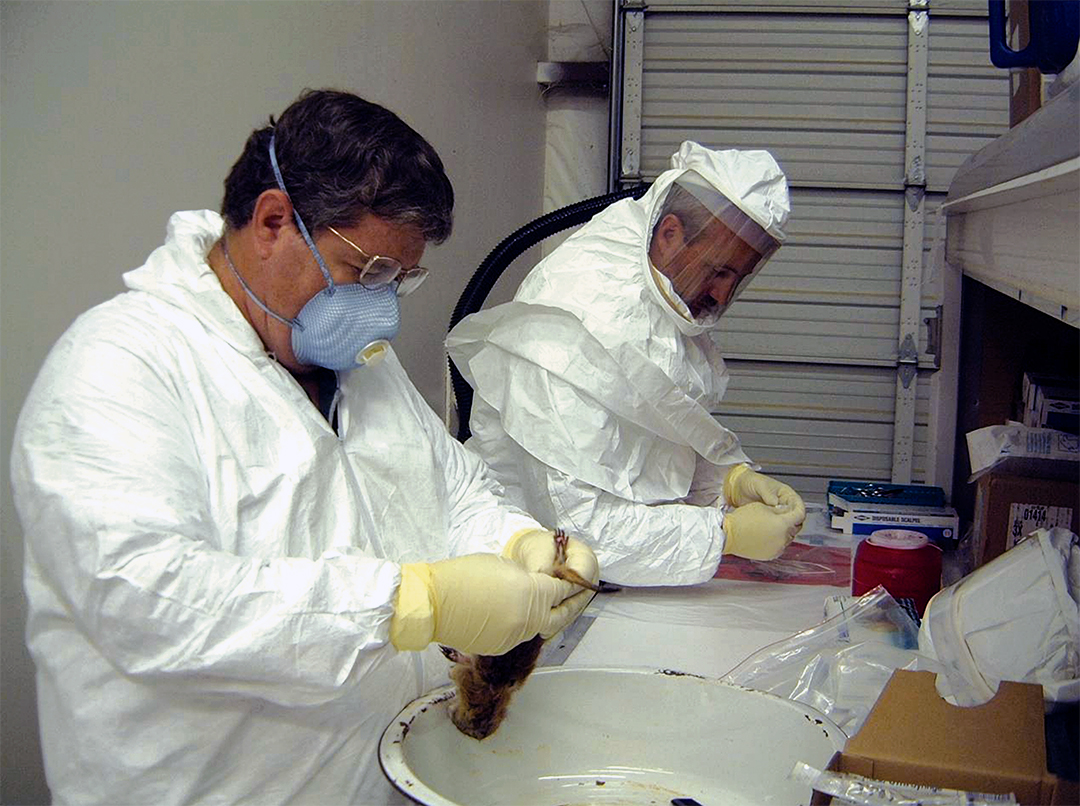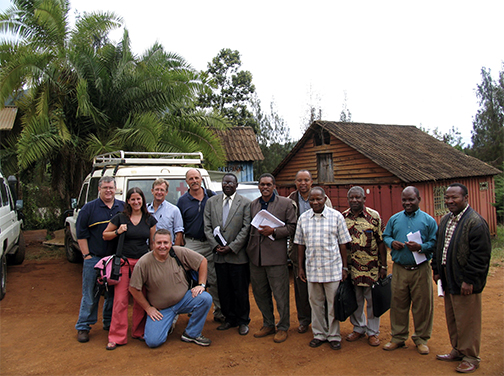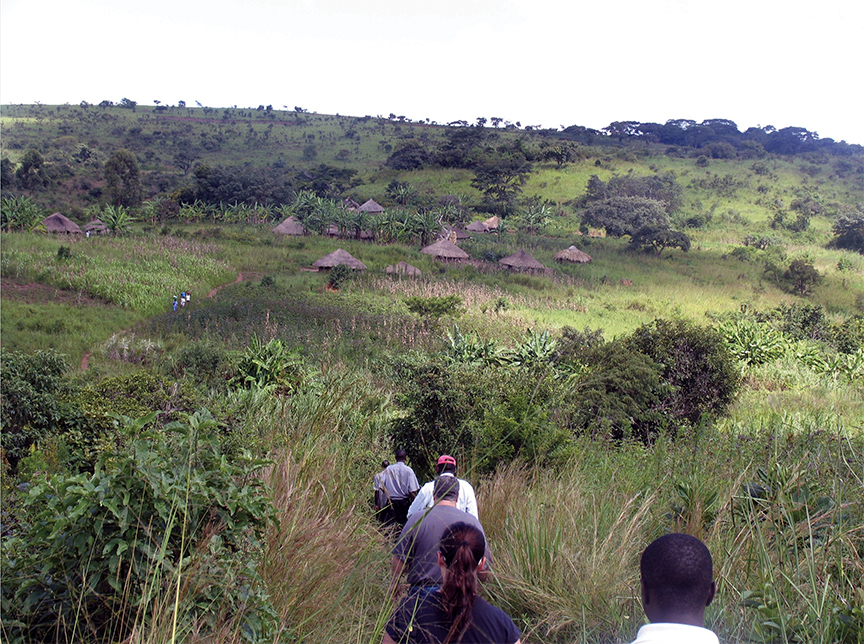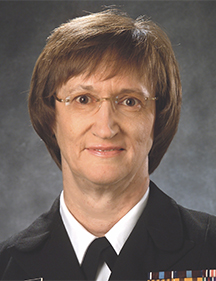
gear to remove tissue samples from prairie dogs that had died at an
exotic pet facility in Texas.
Fleas. Kenneth Gage ’80 has them — by the jarful. One would need a microscope and a manual to identify the subspecies of flea in the curious collection, but among them are some of the more famous pests of all time.
There is Ctenocephalide felis (and its cousin canis), familiar to pet owners and miniature-circus operators the world over. There is Pulex irritans, or the human flea. It was once a scourge of the Old World, so prevalent that even royalty wore fur flea collars.
Then there is Xenopsylla cheopis, or the oriental rat flea, which hardly needs an introduction. It is this specimen that is blamed for the spread of the bubonic plague that killed close to 75 million people in Europe during the Middle Ages. It still kills to this day. It is Gage’s job to stop it.
Gage is the Plague Section Chief for the Flea-Borne Diseases Laboratory of theCenters for Disease Control, a position he has held since 1994. The last outbreak of the plague in the United States occurred in 1925 in Los Angeles (15 years before the CDC was first founded to control malaria), but it persists elsewhere.
According to the CDC, from 1,000 to 3,000 people are infected with the disease each year. When there is an outbreak, no matter if it is in Africa, India or Peru, Gage is dispatched to identify the cause and contain the spread. “The sad thing about that is sometimes we get there too late,” Gage says. “The outbreak may be well on its way by the time we have arrived."

the Lushoto District in Tanzania, an area with
serious plague outbreaks.
Untreated, an infected victim can die within a week, but not before possibly infecting others. Such was the sad case of an outbreak that Gage witnessed in a small village in Ecuador in 1998.
The first to fall was a 13-year-old girl. Gage suspects the girl contracted the plague while skinning an infected guinea pig, which are raised and eaten like chicken in parts of the Andes. The girl’s mother, aunt and nine other family members who attended the girl’s funeral died over the next month.
“The villagers suspected witchcraft,” Gage relates. He arrived to find the family’s hut burned to the ground and a row of fresh graves, “each with a fresh mound of dirt and a handmade cross,” he recalls. In cases such as these, Gage can only hope to educate survivors on prevention. “They don’t want to believe you when you tell them that it was a fleabite that caused it,” he says.
Gage can explain in scientific detail exactly how it is that an oriental rat flea’s gut can become blocked by the bacterium Yersinia pestis, which is endemic in ground rodents such as the rat, squirrel, ground hog, guinea pig and prairie dog, and how such a sickly flea, which can no longer digest its meals, instead regurgitates into the next animal or person it bites.
He is also one of the authors of a recent study that suggests, for the first time, that a human flea does not necessarily have to be blocked with the bacterium before passing the plague on to the next victim, if it has recently feasted on infected blood. But often it is enough to explain to survivors that any fleabite can pass infection and that they should take precautions.

Moscow to set up collaborative research on rodent-
associated pathogens with Gamaleya Institute
scientists.
“You pull the wool blankets out of the huts and into the sunlight and the fleas are hopping off like popcorn,” Gage says. Literature is passed out, the area is sprayed with pesticide, funding may be provided to the local government and health agencies for follow-up. Gage then writes up a report and returns home — but usually not for long.
When there is not an outbreak to tend to, there is lab research and field study. Over the fall, Gage was in Uganda trapping rodents and shaking out their fleas in hopes of determining which rodents were carrying the plague bacterium (northwestern Uganda has suffered numerous plague outbreaks over the past two decades).
Once captured, fleas are freeze-dried or drowned in a saline solution and then studied under a microscope to determine if they are blocked, an indicator of the plague bacterium.
Others are captured alive, culled from a trapped host rat or rock squirrel and transported back to the lab in vials. A pinch of sand, dried blood and rat chow is sprinkled into the vial to tide them over on their journey. The live fleas, it is hoped, will hatch colonies that could be useful for further study.
On such trips, flea hunters pack light. Traps, syringes, specimen vials, rat chow, perhaps a week’s worth of clothes and insect repellent are about all that make it into the pack that Gage carries into the field. “I can’t make myself go anywhere without dragging along a couple of books to read as well,” he adds.

northwestern Uganda to investigate suspected
human plague cases. Rats, which are common
hosts of plague in this area, live in the thatched
roofs of huts and carry fleas that can transmit
plague bacteria to humans.
Sometimes Gage is lucky and the study area is near a town with a hotel. Other times, he roughs it. “On one of my plague consultancies to Peru, I rode a mule to a village in the Andes where we stayed about a week,” he says. “Our stay was quite enjoyable because the people were kind and hospitable. I was, however, ready to change menu items after a week of deep-fat-fried guinea pig.”
Gage joined the CDC in 1992; three other Shockers also work there: Ruth Shults ’79, Ken Meade ’89 and John Anderton ’87.
Gage credits WSU and biology prof Don Distler for sparking his interest in science: “Dr. Distler’s specialty is ecology. I took every course of his I could. Class highlights were his sense of humor, field trips and his ability to make students think biologists and ecologists can make important contributions to society.”
There have been no U.S. outbreaks of the plague for more than 80 years, but that does not mean the disease is not lurking nearby.
Gage suspects he could walk out the doors of the CDC’s Fort Collins, Colo., lab right now, where he and his flea collection are based, and find plague-infected fleas in the foothills.
He did not put them there.
 Ruth Shults ’79 of the U.S. Public Health Service Injury Prevention Center in Atlanta, Ga., is a captain in the Public Health Service Commissioned Corps and senior nurse epidemiologist. The WSU nursing graduate leads the CDC’s research and dissemination activities in the areas of alcohol-impaired driving, teen-driver issues and seat-belt use. After completing a master’s degree in epidemiology, she applied for the CDC’s Epidemic Intelligence Service training program. “In the mid-1980s, CDC was on the forefront of what was to become the AIDS epidemic,” she relates, “and I wanted to be a part of the CDC organization.”
Ruth Shults ’79 of the U.S. Public Health Service Injury Prevention Center in Atlanta, Ga., is a captain in the Public Health Service Commissioned Corps and senior nurse epidemiologist. The WSU nursing graduate leads the CDC’s research and dissemination activities in the areas of alcohol-impaired driving, teen-driver issues and seat-belt use. After completing a master’s degree in epidemiology, she applied for the CDC’s Epidemic Intelligence Service training program. “In the mid-1980s, CDC was on the forefront of what was to become the AIDS epidemic,” she relates, “and I wanted to be a part of the CDC organization.”
 Ken Mead ’89 began active duty in the U.S. Army after graduating with a mechanical engineering degree. He is now a commander in the U.S. Public Health Service Commissioned Corps and works as a research engineer at the National Institute for Occupational Safety and Health in Cincinnati, Ohio. It’s his job to develop engineering solutions that reduce occupational exposures to harmful contaminants. In 2001, he responded to a U.S. Post Office in New Jersey where letters containing anthrax were found. “It was a great experience to see the various sciences (employed by the CDC) work together,” he says about the investigation.
Ken Mead ’89 began active duty in the U.S. Army after graduating with a mechanical engineering degree. He is now a commander in the U.S. Public Health Service Commissioned Corps and works as a research engineer at the National Institute for Occupational Safety and Health in Cincinnati, Ohio. It’s his job to develop engineering solutions that reduce occupational exposures to harmful contaminants. In 2001, he responded to a U.S. Post Office in New Jersey where letters containing anthrax were found. “It was a great experience to see the various sciences (employed by the CDC) work together,” he says about the investigation.
 John Anderton ’87 is the acting associate director for communications science at the National Center for Public Health Informatics in Atlanta, Ga., where he works with fellow communication professionals “to promote the role and function of public health in people’s daily lives and to highlight the role of the CDC in public health,” as he explains. He utilizes a wide range of media activities to promote such issues as childhood immunization; advances in combating infectious diseases; and HIV, STD and TB prevention. He conducted crisis communication during 2001’s anthrax attacks and the influenza vaccine shortage of 2004.
John Anderton ’87 is the acting associate director for communications science at the National Center for Public Health Informatics in Atlanta, Ga., where he works with fellow communication professionals “to promote the role and function of public health in people’s daily lives and to highlight the role of the CDC in public health,” as he explains. He utilizes a wide range of media activities to promote such issues as childhood immunization; advances in combating infectious diseases; and HIV, STD and TB prevention. He conducted crisis communication during 2001’s anthrax attacks and the influenza vaccine shortage of 2004.





